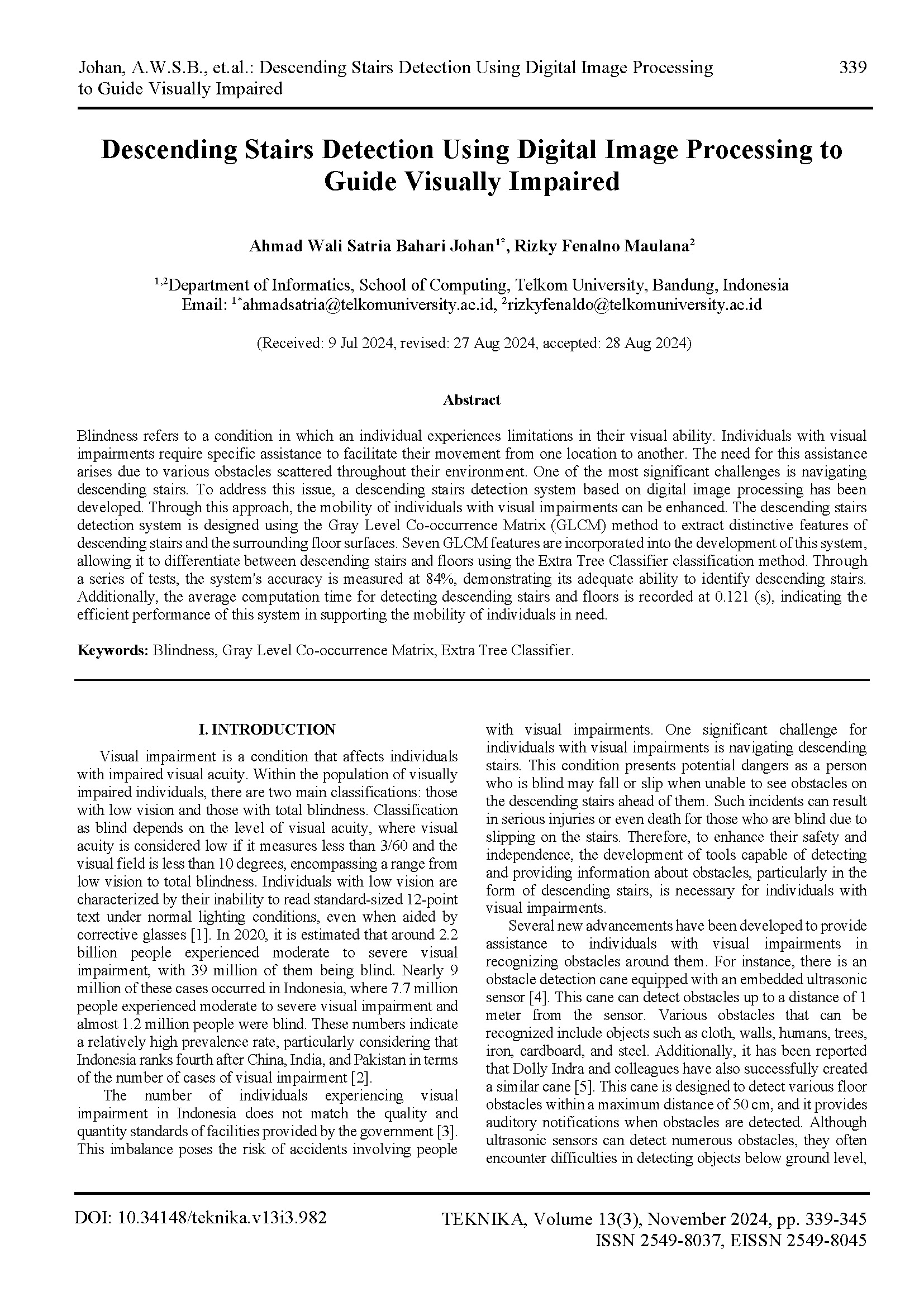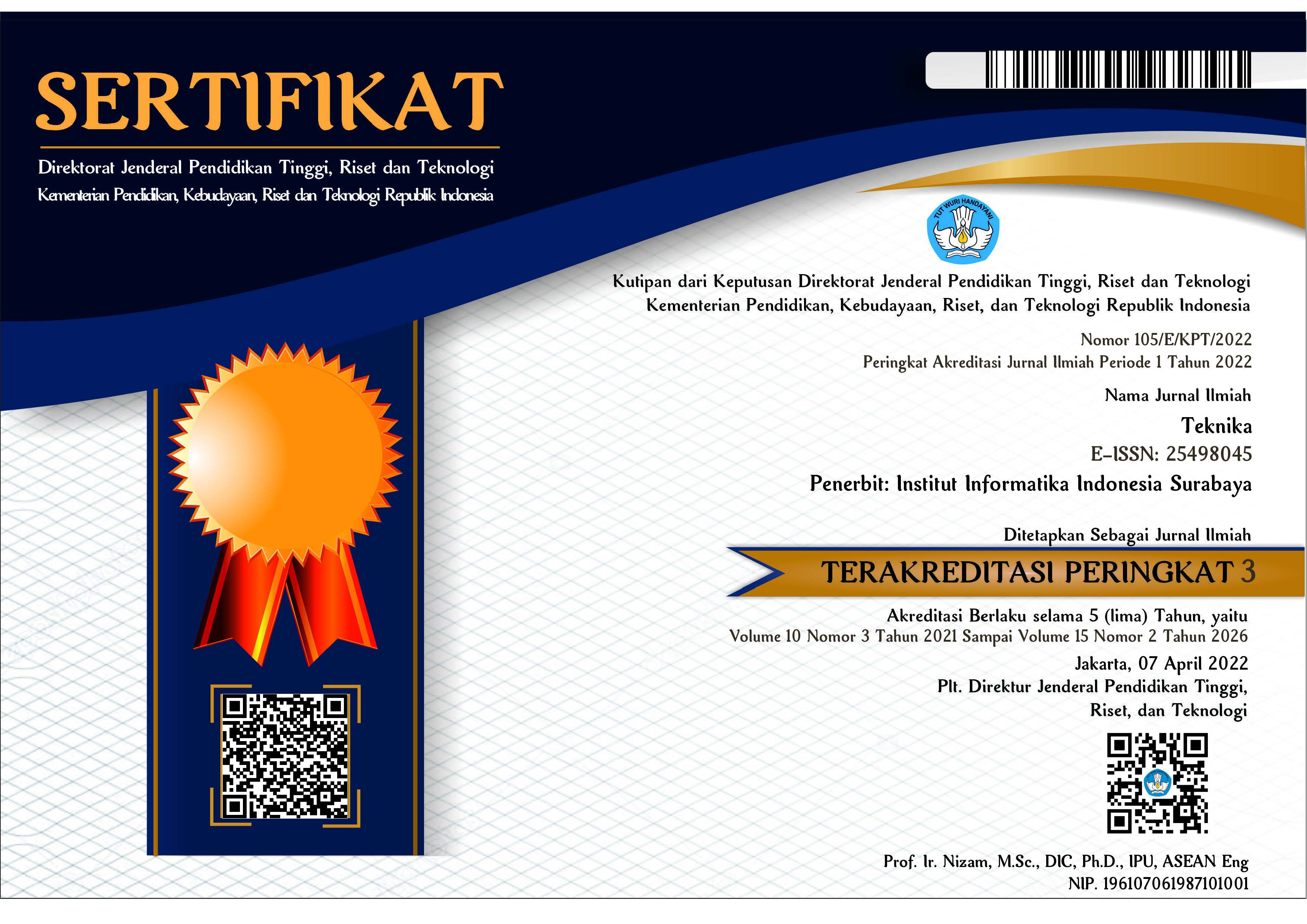Descending Stairs Detection Using Digital Image Processing to Guide Visually Impaired
DOI:
https://doi.org/10.34148/teknika.v13i3.982Keywords:
Blindness, Gray Level Co-occurrence Matrix, Extra Tree ClassifierAbstract
Blindness refers to a condition in which an individual experiences limitations in their visual ability. Individuals with visual impairments require specific assistance to facilitate their movement from one location to another. The need for this assistance arises due to various obstacles scattered throughout their environment. One of the most significant challenges is navigating descending stairs. To address this issue, a descending stairs detection system based on digital image processing has been developed. Through this approach, the mobility of individuals with visual impairments can be enhanced. The descending stairs detection system is designed using the Gray Level Co-occurrence Matrix (GLCM) method to extract distinctive features of descending stairs and the surrounding floor surfaces. Seven GLCM features are incorporated into the development of this system, allowing it to differentiate between descending stairs and floors using the Extra Tree Classifier classification method. Through a series of tests, the system's accuracy is measured at 84%, demonstrating its adequate ability to identify descending stairs. Additionally, the average computation time for detecting descending stairs and floors is recorded at 0.121 (s), indicating the efficient performance of this system in supporting the mobility of individuals in need.
Downloads
References
R. R. A. Bourne et al., ‘Causes of blindness and vision impairment in 2020 and trends over 30 years, and prevalence of avoidable blindness in relation to VISION 2020: The Right to Sight: An analysis for the Global Burden of Disease Study’, Lancet Glob. Heal., vol. 9, no. 2, pp. e144–e160, 2021, doi: 10.1016/S2214-109X(20)30489-7.
S. Naipal and N. Rampersad, ‘Visual ability in adolescents with visual impairment’, Br. J. Vis. Impair., vol. 38, no. 2, pp. 151–159, 2020, doi: 10.1177/0264619619892993.
N. Karniawati, ‘Aspek Tangibles Dalam Pelayanan Aksesibilitas Trotoar Jalan Bagi Penyandang Disabilitas Tunanetra Di Kota Bandung’, J. Agreg. Aksi Reformasi Gov. dalam Demokr., vol. 6, no. 2, 2018, doi: 10.34010/agregasi.v6i2.1138.
J. B. Purnomo, M. A. Jani, and A. Kridoyono, ‘Tongkat Pendeteksi Halangan Untuk Penderita Tunanetra Dengan Sensor Ultrasonik Menggunakan Tenaga Surya’, Konvergensi, vol. 14, no. 2, 2019, doi: 10.30996/konv.v14i2.2777.
D. Indra, A. Rachman Manga, E. Irawadi Alwi, S. Hajrah Mansyur, L. Nurhayati, and A. Moehammad Fajrin, ‘Implementasi Tongkat Cerdas sebagai Alat Navigasi bagi Penyandang Tuna Netra Implementation of Intelligent Stick as a Navigation Tool for The Blind People’, Pros. Semin. Nas. Komun. dan Inform. #3 Tahun, vol. 2019, pp. 17–20, 2019.
S. Bharambe, R. Thakker, H. Patil, and K. M. Bhurchandi, ‘Substitute eyes for blind with navigator using android’, Proc. - 2013 Texas Instruments India Educ. Conf. TIIEC 2013, pp. 38–43, 2013, doi: 10.1109/TIIEC.2013.14.
A. Wali, S. Bahari, F. Utaminingrum, and A. S. Budi, ‘K- Value Effect Based on Combination GLCM Angle and KNN for Detecting Smart Wheelchair’, vol. 5, no. 1, pp. 23–31, 2020.
N. Iqbal, R. Mumtaz, U. Shafi, and S. M. H. Zaidi, ‘Gray level co-occurrence matrix (GLCM) texture based crop classification using low altitude remote sensing platforms’, PeerJ Comput. Sci., vol. 7, pp. 1–26, 2021, doi: 10.7717/PEERJ-CS.536.
A. W. Satria Bahari Johan, S. W. Putri, G. Hajar, and A. Y. Wicaksono, ‘Modified KNN-LVQ for Stairs Down Detection Based on Digital Image’, Lontar Komput. J. Ilm. Teknol. Inf., vol. 12, no. 3, p. 141, 2021, doi: 10.24843/lkjiti.2021.v12.i03.p02.
P. Mohanaiah, P. Sathyanarayana, and L. Gurukumar, ‘Image Texture Feature Extraction Using GLCM Approach’, Int. J. Sci. Res. Publ., vol. 3, no. 5, pp. 1–5, 2013.
S. A. Alazawi, N. M. Shati, and A. H. Abbas, ‘Texture features extraction based on GLCM for face retrieval system’, Period. Eng. Nat. Sci., vol. 7, no. 3, pp. 1459–1467, 2019, doi: 10.21533/pen.v7i3.787.
Y. Chen and X. Chen, ‘Tea leaves identification based on gray-level Co-occurrence matrix and K-nearest neighbors algorithm’, AIP Conf. Proc., vol. 2073, no. February, 2019, doi: 10.1063/1.5090738.
M. Lu, Y. Liu, W. He, and X. Li, ‘Skin Roughness Evaluation Method Based on gray level co-occurrence matrix’, Proc. 31st Chinese Control Decis. Conf. CCDC 2019, pp. 5671–5674, 2019, doi: 10.1109/CCDC.2019.8832978.
L. Abhishek, ‘Optical character recognition using ensemble of SVM, MLP and extra trees classifier’, 2020 Int. Conf. Emerg. Technol. INCET 2020, pp. 7–10, 2020, doi: 10.1109/INCET49848.2020.9154050.
O. Z. Jie, L. T. Ming, and T. C. Wee, ‘Biometric Authentication based on Liveness Detection Using Face Landmarks and Deep Learning Model’, Int. J. Informatics Vis., vol. 7, no. 3–2, pp. 1057–1065, 2023, doi: 10.30630/joiv.7.3-2.2330.
S. Shrestha, ‘R eal T ime D rowsiness D etection S ystem U sing F acial L andmarks’, no. January, 2024.
S. Gu, F. Wang, N. P. Patel, J. A. Bourgeois, and J. H. Huang, ‘A model for basic emotions using observations of behavior in Drosophila’, Front. Psychol., vol. 10, no. APR, pp. 1–13, 2019, doi: 10.3389/fpsyg.2019.00781.
L. Atikah, N. A. Hasanah, R. Sarno, A. Fajar, and D. Rahmawati, ‘Brain segmentation using adaptive thresholding, k-means clustering and mathematical morphology in MRI Data’, Proc. - 2020 Int. Semin. Appl. Technol. Inf. Commun. IT Challenges Sustain. Scalability, Secur. Age Digit. Disruption, iSemantic 2020, pp. 161–167, 2020, doi: 10.1109/iSemantic50169.2020.9234303.























